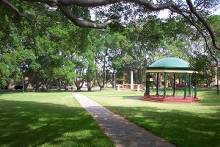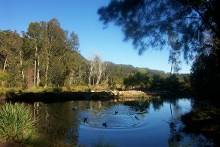|
Mortdale Memorial Park
Mortdale Memorial Park is a reserve located in the southern Sydney suburb of Mortdale. It contains a war memorial commemorating local people who served their country in time of war. The park is a popular place for picnics, weddings, and concerts. History The land which now forms Mortdale Park was originally home to a small brick pit where hand-made bricks were produced. This operation ceased in 1884 when the Mortdale Brickworks was established near Mortdale Public School.Mortdale in Early Days, DJ Hatton, 1981 Mortdale Park had a very difficult beginning. Many different associations vied for their own piece of land in Mortdale for a park – the local Chamber of Commerce, the RSL, the local Parents & Citizens group and the Council. Debate started in September 1924 when residents asked for a park on the corner of Victoria Avenue and Cook Street. Within a year the Chamber of Commerce put forward an alternative at the corner of Morts and Forest Roads. Over the next few years both ... [...More Info...] [...Related Items...] OR: [Wikipedia] [Google] [Baidu] |
Sydney
Sydney ( ) is the capital city of the state of New South Wales, and the most populous city in both Australia and Oceania. Located on Australia's east coast, the metropolis surrounds Sydney Harbour and extends about towards the Blue Mountains to the west, Hawkesbury to the north, the Royal National Park to the south and Macarthur to the south-west. Sydney is made up of 658 suburbs, spread across 33 local government areas. Residents of the city are known as "Sydneysiders". The 2021 census recorded the population of Greater Sydney as 5,231,150, meaning the city is home to approximately 66% of the state's population. Estimated resident population, 30 June 2017. Nicknames of the city include the 'Emerald City' and the 'Harbour City'. Aboriginal Australians have inhabited the Greater Sydney region for at least 30,000 years, and Aboriginal engravings and cultural sites are common throughout Greater Sydney. The traditional custodians of the land on which modern Sydney stands are ... [...More Info...] [...Related Items...] OR: [Wikipedia] [Google] [Baidu] |
Mortdale
Mortdale is a suburb located in southern Sydney, in the state of New South Wales, Australia. Mortdale is located 20 kilometres south of the Sydney central business district and is part of the St George area. Mortdale is situated in the local government area of Georges River Council. Mortdale extends south to Lime Kiln Bay, on the Georges River. Mortdale Heights is a locality in the western corner of the suburb. History Mortdale has been known in the past as Mort's Road, Mort's Hill, Mort's Crossing, Mort's Township and Mort Dale. The suburb was named after Sydney industrialist Thomas Sutcliffe Mort (1816–1878), who was famous for pioneering the refrigeration of shipping meat and the construction of Mort's Dock, Balmain. Thomas Mort purchased the land from Robert Townson (1763–1827), who had been granted land in the Hurstville area with his brother John Townson. A small farming community started when the land around Mort's Road was subdivided into 17 farms. The Hurstvi ... [...More Info...] [...Related Items...] OR: [Wikipedia] [Google] [Baidu] |
Cenotaph
A cenotaph is an empty tomb or a monument erected in honour of a person or group of people whose remains are elsewhere. It can also be the initial tomb for a person who has since been reinterred elsewhere. Although the vast majority of cenotaphs honour individuals, many noted cenotaphs are instead dedicated to the memories of groups of individuals, such as the lost soldiers of a country or of an empire. Etymology The word "cenotaph" in the English Language is derived from the Greek el, κενοτάφιον, kenotaphion, label=none. It is a compound word that is created from the morphological combination of two root words: # el, κενός, kenos, label=none meaning "empty" # el, τάφος, taphos, label=none meaning "tomb", from el, θαπτω, thapto, I bury, label=none History Cenotaphs were common in the ancient world. Many were built in Ancient Egypt, Ancient Greece and across Northern Europe (in the shape of Neolithic barrows). The cenotaph in Whitehall, Lon ... [...More Info...] [...Related Items...] OR: [Wikipedia] [Google] [Baidu] |
Rotunda (architecture)
A rotunda () is any building with a circular ground plan, and sometimes covered by a dome. It may also refer to a round room within a building (a famous example being the one below the dome of the United States Capitol in Washington, D.C.). The Pantheon in Rome is a famous rotunda. A ''band rotunda'' is a circular bandstand, usually with a dome. Rotunda in Central Europe A great number of parochial churches were built in this form in the 9th to 11th centuries CE in Central Europe. These round churches can be found in great number in Hungary, Poland, Slovakia, Croatia (particularly Dalmatia) Austria, Bavaria, Germany, and the Czech Republic. It was thought of as a structure descending from the Roman Pantheon. However, it can be found mainly not on former Roman territories, but in Central Europe. Generally its size was 6–9 meters inner diameter and the apse was directed toward the east. Sometimes three or four apses were attached to the central circle and this type has relatives ... [...More Info...] [...Related Items...] OR: [Wikipedia] [Google] [Baidu] |
Small-leaved Fig
''Ficus obliqua'', commonly known as the small-leaved fig, is a tree in the family Moraceae, native to eastern Australia, New Guinea, eastern Indonesia to Sulawesi and islands in the southwestern Pacific Ocean. Previously known for many years as ''Ficus eugenioides'', it is a banyan of the genus ''Ficus'', which contains around 750 species worldwide in warm climates, including the edible fig (''Ficus carica''). Beginning life as a seedling, which grows on other plants ( epiphyte) or on rocks (lithophyte), ''F. obliqua'' can grow to high and nearly as wide with a pale grey buttressed trunk, and glossy green leaves. The small round yellow fruit ripen and turn red at any time of year, although ripening peaks in autumn and winter (April to July). Known as a syconium, the fruit is an inverted inflorescence with the flowers lining an internal cavity. ''Ficus obliqua'' is pollinated by two species of fig wasp—'' Pleistodontes greenwoodi'' and '' P. xanthocephalus''. ... [...More Info...] [...Related Items...] OR: [Wikipedia] [Google] [Baidu] |
Parks In Sydney
Sydney is well endowed with open spaces and has many natural areas. Many of these exist even within the compact city centre. These include the Chinese Garden of Friendship and Hyde Park (which is named after London's Hyde Park). The metropolitan area contains several national parks, including the Royal National Park, the second oldest national park in the world (after Yellowstone National Park), which occupies an area of . Completing Sydney's wide array of green spaces, the leader is the Royal Botanical Gardens, with its large amount of green spaces, lush plants and colourful flowers. Although Sydney developed organically after the arrival of the First Fleet, the city parks and open spaces were a part of early town planning to provide relief from the bustle and monotony of the city streets. Hyde Park is the oldest park in the city. Largest parks in Sydney metropolitan area Largest parks in the City of Sydney area Parks and reserves The following is an incomplete lis ... [...More Info...] [...Related Items...] OR: [Wikipedia] [Google] [Baidu] |






